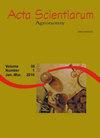食品用木薯淀粉糊化特性的表型多样性
IF 1.2
4区 农林科学
Q3 AGRONOMY
引用次数: 0
摘要
本研究的目的是根据淀粉的糊化特性来评估木薯的表型变异和多样性,以供育种使用。从1031份原料中提取淀粉,用快速粘度分析仪测定淀粉的粘度。根据粘图的五个临界点计算出最佳的线性无偏预测因子,然后根据主成分的判别分析将其用于聚类。从粘图中鉴定出的广泛表型变异揭示了选择增益的高潜力,特别是在粘贴温度和挫折方面。某些强相关性表明,基于特定粘谱特征的选择可用于间接选择(例如,峰值粘度与击穿之间的相关性[0.85])。最低的贝叶斯信息标准确定了五个不同的群体。第3组和第4组粘贴温度较高,第3组和第5组粘贴温度较低。3组也表现出低粘度和低击穿。然而,我们专注于选择具有高糊化温度和低挫折的木薯材料,因为这些是工业应用最重要的特性。提高糊温和减少挫折的前15个木薯材料的预测遗传增益分别为4.40%和53.17%。选择导致的糊化温度升高(~72.89℃)和退坡幅度高(~600 cP),可以指导木薯种质资源的育种利用,为进一步研究开发具有附加值的品种,特别是食品工业附加值品种提供基础。本文章由计算机程序翻译,如有差异,请以英文原文为准。
Phenotypic diversity of starch pasting properties in cassava for food industry
The aim of this study was to evaluate the phenotypic variation and diversity of cassava for breeding purposes based on the pasting properties of starch, for food applications. The viscosities of the starches, extracted from 1031 accessions, were obtained using a Rapid Visco Analyzer. The best linear unbiased predictors were calculated for five critical points of the viscograms, which were then used to cluster the accessions based on the discriminant analysis of principal components. The wide phenotypic variation identified from the viscograms reveals the high potential for selection gains, especially for pasting temperature and setback. Certain strong correlations indicate that selection based on a specific viscogram trait can be used for indirect selection (e.g., the correlation between peak viscosity and breakdown [0.85]). The lowest Bayesian information criterion identified five different groups. Groups 3 and 4 exhibited high pasting temperatures, while Groups 3 and 5 exhibited low setbacks. Group 3 also exhibited low viscosity and breakdown. However, we focused on selecting cassava accessions with a high pasting temperature and low setback, as these are the most important traits for industrial applications. The predicted genetic gains from the selection of the top 15 cassava accessions for increasing pasting temperature and decreasing setback were 4.40% and 53.17%, respectively. The increased pasting temperature (~72.89°C) and high amplitude of setback (~600 cP) due to selection can guide the utilization of the cassava germplasm for breeding and provide a basis for further studies to develop varieties with added value, especially in the food industry.
求助全文
通过发布文献求助,成功后即可免费获取论文全文。
去求助
来源期刊

Acta Scientiarum. Agronomy.
Agricultural and Biological Sciences-Agronomy and Crop Science
CiteScore
2.40
自引率
0.00%
发文量
45
审稿时长
>12 weeks
期刊介绍:
The journal publishes original articles in all areas of Agronomy, including soil sciences, agricultural entomology, soil fertility and manuring, soil physics, physiology of cultivated plants, phytopathology, phyto-health, phytotechny, genesis, morphology and soil classification, management and conservation of soil, integrated management of plant pests, vegetal improvement, agricultural microbiology, agricultural parasitology, production and processing of seeds.
 求助内容:
求助内容: 应助结果提醒方式:
应助结果提醒方式:


